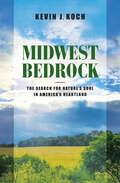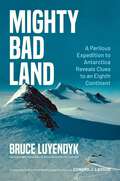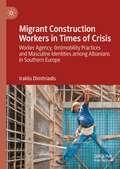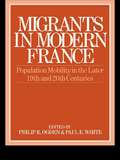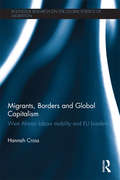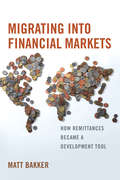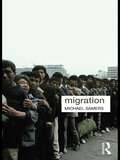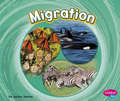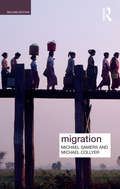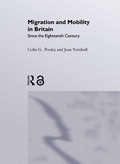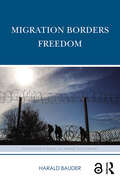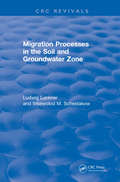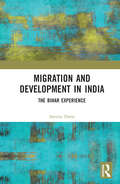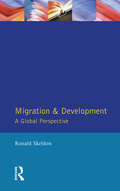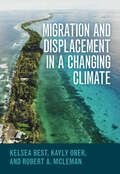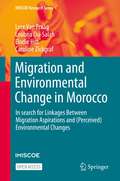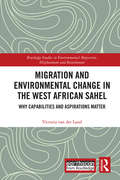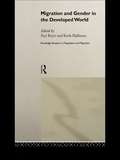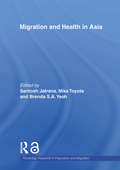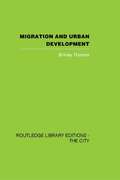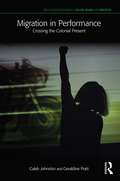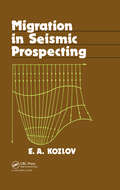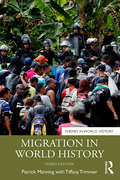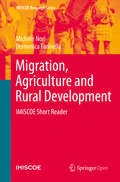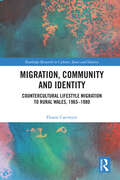- Table View
- List View
Midwest Bedrock: The Search for Nature's Soul in America's Heartland (Heartland History)
by Kevin J. KochTo know a place deeply means to understand it on several levels, layered almost as if from bedrock to topsoil. Midwest Bedrock: The Search for Nature's Soul in America's Heartland takes readers on a journey across all twelve Midwest states to natural settings that defy typical stereotypes of the Midwest landscape. Each chapter focuses on one focal region or locality within each state, often seeking out lesser-known landscapes steeped in beauty and story.Author Kevin Koch invites readers to join him on a journey through the beauty of the Midwest and to discover such places as Wisconsin's 1,100-mile Ice Age Trail that follows the furthest reach of the last glacier; Minnesota's Lake Itasca, headwaters of the Mississippi River; and Indiana's Hoosier National Forest, which still cradles hidden graveyards from long-abandoned farm communities. Part history, part memoir, part interview-based research, Midwest Bedrock is a personal narrative of exploring the natural beauty of America's Heartland, where each location tells the stories of the past that linger on the landscape.
Mighty Bad Land: A Perilous Expedition to Antarctica Reveals Clues to an Eighth Continent
by Bruce LuyendykA tale of grit and real teamwork in the wilds of Antarctica when the hunger for knowledge reigns supreme.Anything can happen in a pure wilderness experienced by few humans—a place where unseen menace waits everywhere. This story is an unembellished account of a scientist and his team exploring the last place on Earth. But, unlike most recent books on Antarctica, the reader becomes embedded with geologist Bruce Luyendyk&’s team. They share the challenges, companionship, failures, bravery, and success brought to light from scientific research pursued in an unforgiving place, Marie Byrd Land, or Mighty Bad Land. The geologists make surprising discoveries. Luyendyk realizes that vast submarine plateaus in the southwest Pacific are continental pieces that broke away from the Marie Byrd Land sector of Gondwana. He coined &“Zealandia&” to describe this newly recognized submerged continent. Only the tops of its mountains poke above sea level to host the nation of New Zealand. This stunning revelation of a submerged eighth continent promises economic and geopolitical consequences reverberating into the twenty-first century. The story occurs in the 1990s and fills a gap in the timeline of Antarctic exploration between the Heroic Age, the age of military exploration, and before the modern era of science. Danger is exponentially greater, isolation a constant threat without GPS, satellite phones, and the internet. As the expedition&’s leader, Luyendyk stands up to his demons that surface under the extreme duress of his experience, like nearly losing two team members.
Migrant Construction Workers in Times of Crisis: Worker Agency, (Im)mobility Practices and Masculine Identities among Albanians in Southern Europe
by Iraklis DimitriadisThis book explores how migrant construction workers in Southern Europe faced unemployment and precarious work conditions during and after the Great Recession. By drawing on rich qualitative data, it investigates the experiences of Albanian men within and beyond the workplace, and sheds light on the capacity of migrant builders to deal with economic hardships and the role of their families and masculine identities in shaping their coping practices. This book suggests a new framework for the study of coping practices among migrant (construction) workers, and adds to the study of integration processes in Southern European countries by comparing the narratives of settled migrants in Italy and Greece. This book also looks at the effects of the COVID-19 pandemic on migrant builders’ lives in Southern Europe. By adopting an interdisciplinary approach, this book is of interest both to students and researchers in the field of migration studies and those working in the fields of sociology, geography, anthropology, political science and economics.
Migrants in Modern France
by Philip E. Ogden Paul E. WhiteA discussion of the structure and role of migration flows affecting France from 1850 to the present day. It covers both internal and international movements and consideration is given both to broad macro-scale analysis and more detailed micro-scale investigations.
Migrants, Borders and Global Capitalism: West African Labour Mobility and EU Borders
by Hannah CrossPeople from West Africa are risking their lives and surrendering their citizenship rights to enter exploitative labour markets in Europe. This book offers an explanation for this phenomenon that is based on close analysis of the contradictory economic and political agendas that create and constrain labour migration. It shows how global capitalism regulates different stages of the process within an interconnected system of economic dispossession, the construction of an illegal status, border control, labour exploitation and processes of underdevelopment. This is summarised as a regime of ‘unfree labour mobility’. Combined with structural and historical approaches, this book is based on ethnographic research. It incorporates those who are left behind, those who decide to stay, migrants who fail and those who are on the move, alongside clustered migrant communities in Senegal, Mauritania and Spain. The book’s panoramic approach shows how West African ‘step-wise’ journeys to Europe by land and sea sees competing territorial and economic policies regulating an unstable and unpredictable trajectory, creating ‘illegal’ labour through dual logics of border security and selective labour mobility. This book demonstrates that the diverse channels through which people migrate in the modern era are mediated by European states and labour markets, which utilise border regimes to control labour and be globally competitive. The themes and patterns that emerge, in their context of inter-generational change, present a challenge to the accepted wisdom about the individual and household dynamics of labour migration. This book is of interest to students and scholars of migration, transnationalism, politics, security, development, economics, and sociology.
Migrating into Financial Markets: How Remittances Became a Development Tool
by Matt BakkerA free ebook version of this title is available through Luminos, University of California Press' new open access publishing program for monographs. Visit www.luminosoa.org to learn more. We understand very little about the billions of dollars that flow throughout the world from migrants back to their home countries. In this rigorous and illuminating work, Matt Bakker, an economic sociologist, examines how these migrant remittances--the resources of some of the world's least affluent people--have come to be seen in recent years as a fundamental contributor to development in the migrant-sending states of the Global South. This book analyzes how the connection between remittances and development was forged through the concrete political and intellectual practices of policy entrepreneurs within a variety of institutional settings, from national government agencies and international development organizations to nongovernmental policy foundations and think tanks.
Migration
by Michael SamersIn the context of global security concerns, humanitarian crises and skill shortages migration and immigration have become central to economic, political and social debates at the beginning of the twenty-first century. And while migration and immigration have certainly not escaped the attention of social scientists, the study of both remains the most ‘under-serviced’ academic domain with respect to introductory texts. It is not surprising then that even fewer books have explored the contours of these social phenomena from an explicitly geographical perspective – in other words, in terms of ‘space’, ‘place’ and ‘scale’. Migration is an advanced, yet accessible, introduction to migration and immigration in a global context. It offers a critical, multi-disciplinary approach to the subject, borrowing from human geography, political science, social anthropology and sociology. However, unlike other broad volumes on the subject, it emphasizes a theoretical and conceptual approach to the study of migration. Specifically, Migration adopts a unique geographical approach by employing spatial concepts such as place, scale and territory. Using these spatial concepts, the author argues that most studies of migration begin with either an undue emphasis on nation-states as a lens on migration or on the contrary rely on exaggerated notions of transnationalism. Migration neither neglects the importance of nation states nor the significance of transnationalism, but it focuses on how local contexts matter to migration. The book covers such topics as migration categories, the explanation of different forms of migration, migration and employment, the geopolitics of migration and immigration and citizenship, rights, and belonging. This text is not simply an encyclopaedic overview of migration theories, trends and facts; rather, it is designed to have lasting intellectual value by providing particular arguments in each theme-based chapter. While it advocates certain arguments, it is also clearly written in an engaging and accessible manner for an undergraduate audience. Its clear structure is complemented by a combination of pedagogical features, such as case-study boxes, summary questions at the end of each chapter and a glossary. The book is designed for courses and modules on migration and immigration at the undergraduate and postgraduate levels and both students and academics will find it exceptionally useful.
Migration (Cycles of Nature)
by Jaclyn JaycoxZebras travel across the Kalahari Desert each spring in search of food. Whales swim to warmer water every winter. Take a journey to discover the wonders of migrating animals, including why they migrate and how far they travel.
Migration (Key Ideas in Geography)
by Michael Collyer Michael SamersWhile the subject of migration has received enormous attention in academic journals and books across the social sciences, introductory texts on the matter are few and far between. Even fewer books have explored migration through a critical and explicit engagement with spatial concepts. Now in its second edition, Migration remains the only text in more than a decade that emphasizes how geographical or spatial concepts can be used critically to understand migration. The multi-disciplinary text draws on insights from human geography, political science, social anthropology, sociology, and to a lesser extent economics. All of the chapters focus on key terms, theories, concepts, and issues concerning migration and immigration. The book argues that in the context of migration, two opposing ‘spatial positions’ have emerged in the wake of the critique of ‘methodological nationalism’. On one hand is the significance of ‘transnationalism’, and on the other, the importance of ‘sub-national’ or local processes. Both require more nuance and integration, while many of the concepts and theories which have thus far neglected space or have not been ‘treated’ spatially, need to be re-written with space in mind. Pedagogically the text combines a carefully defined structure, accessible language, boxes that explore case studies of migrant-related experiences in particular places, annotated suggestions for further reading, useful websites and relevant films and summary questions for student learning at the end of each chapter. Migration provides a critical, multi-disciplinary, advanced, and theoretically informed introduction to migration and immigration. Revised and updated with new material, new maps and illustrations and an accompanying website (https://migration2ndedition.wordpress.com/), it continues to be aimed at advanced undergraduates and Masters-level graduate students undertaking courses on migration and immigration.
Migration And Mobility In Britain Since The Eighteenth Century
by Jean Turnbull Colin PooleyPoplulation migration is one of the demographic and social processes which have structured the British economy and society over the last 250 years. It affects individuals, families, communities, places, economic and social structures and governments. This book examines the pattern and process of migration in Britain over the last three centuries. Using late 1990s research and data, the authors have shed light on migrations patterns including internal migration and movement overseas, its impact on social and economic change, and highlights differences by gender, age, family, position, socio-economic status and other variables.
Migration Borders Freedom (Routledge Studies in Human Geography)
by Harald BauderInternational borders have become deadly barriers of a proportion rivaled only by war or natural disaster. Yet despite the damage created by borders, most people can’t – or don’t want to – imagine a world without them. What alternatives do we have to prevent the deadly results of contemporary borders? In today’s world, national citizenship determines a person’s ability to migrate across borders. Migration Borders Freedom questions that premise. Recognizing the magnitude of deaths occurring at contemporary borders worldwide, the book problematizes the concept of the border and develops arguments for open borders and a world without borders. It explores alternative possibilities, ranging from the practical to the utopian, that link migration with ideas of community, citizenship, and belonging. The author calls into question the conventional political imagination that assumes migration and citizenship to be responsibilities of nation states, rather than cities. While the book draws on the theoretical work of thinkers such as Ernst Bloch, David Harvey, and Henry Lefebvre, it also presents international empirical examples of policies and practices on migration and claims of belonging. In this way, the book equips the reader with the practical and conceptual tools for political action, activist practice, and scholarly engagement to achieve greater justice for people who are on the move.
Migration Processes in the Soil and Groundwater Zone (CRC Press Revivals)
by Ludwig LucknerThis comprehensive work integrates knowledge from physics, chemistry, biology, mathematics, geology, engineering, and several other fields. Its purpose is to provide solution methods, techniques of parameter estimation, and tools for solving the complex problems of mathematical modeling. The main topics presented include fundamentals of mathematical modeling of migration processes; analytical, numerical, and inverse solutions to migration problems; and techniques of parameter estimation and monitoring of migration processes. The book is perfect for anyone involved in the areas of hydrogeology, soil science, environmental engineering, subsurface cleanup, water sciences, agronomy, land development, and civil engineering. It provides professionals with a survey of the methodology of migration model building, the mathematical tools for solving these models, and the technique of parameter estimation in laboratories and in the field. Consultants will appreciate the book's multidisciplinary theoretical background and first approximations for a broad variety of migration data. Professors and students gain an integrated survey of subsurface solute and heat transport, storage, transformation, and exchange processes in both theoretical and practical applications, complete with example problems and solutions.
Migration and Development in India: The Bihar Experience
by Amrita DattaThis book deals with a wide range of issues related to rural-urban migration in the context of neoliberal economic development in India. Focusing on three core areas, first it traces state discourses on rural-urban migration in India since the 1930s critically analysing its industrial, labour, rural and urban programmes, and policies. Second, through data on longitudinal surveys undertaken in rural Bihar in 1999, 2011 and 2016, it examines changes in patterns of migration and sources of income; estimates determinants and impacts of migration. Third, based on fieldwork in the village and the city, it presents an in-depth account of a rural-urban migration stream in contemporary India. It shows how, contrary to the results of conventional data sources such as the Census and NSSO, that mobility is high in rural Bihar, and has significantly increased over time as a result of rising labour demand in distant urban markets elsewhere in India. Further, it also provides evidence of decoupling of agriculture from the ‘rural’ in India. Combining quantitative and qualitative methods in development research, this book will be of great interest to scholars and researchers of development studies, migration studies, development economics, sociology, demography, public policy, and South Asian studies.
Migration and Development: A Global Perspective (Longman Development Studies)
by Ronald SkeldonThe first text that specifically links both international and internal migration with development at a global level. The world is divided into a series of functionally integrated development zones which are identified, not simply on the basis of their level of development, but also through their spatial patterns and historical experience of migration. Migration and Development stresses the importance of migration in discussing regional, rather than simply country, differences. These variations in mobility are placed within the context of a global hierarchy, although regional, national and local cultural and social conditions are certainly not ignored in this wide-ranging work.
Migration and Displacement in a Changing Climate
by Kelsea Best Kayly Ober Robert A. McLemanThis book provides insight into the impact of climate change on human mobility - including both migration and displacement - by synthesizing key concepts, research, methodology, policy, and emerging issues surrounding the topic. It illuminates the connections between climate change and its implications for voluntary migration, involuntary displacement, and immobility by providing examples from around the world. The chapters use the latest findings from the natural and social sciences to identify key interactions shaping current climate-related migration, displacement, and immobility; predict future changes in those patterns and methods used to model them; summarize key policy and governance instruments available to us to manage the movements of people in a changing climate; and offer directions for future research and opportunities. This book will be valuable for students, researchers, and policy makers of geography, environmental science, climate and sustainability studies, demography, sociology, public policy, and political science.
Migration and Environmental Change in Morocco: In search for Linkages Between Migration Aspirations and (Perceived) Environmental Changes (IMISCOE Research Series)
by Caroline Zickgraf Lore Van Praag Loubna Ou-Salah Elodie HutThis open access book studies the migration aspirations and trajectories of people living in two regions in Morocco that are highly affected by environmental change or emigration, namely Tangier and Tinghir, as well as the migration trajectories of immigrants coming from these regions currently living in Belgium. This book departs from the development of a new theoretical framework on the relationship between environmental changes and migration that can be applied to the Moroccan case. Qualitative research conducted in both countries demonstrate how the interplay between migration and environmental factors is not as straightforward as it seems, due to its wider social, political, economic, demographic and environmental context. Findings show how existing cultures of migration, remittances, views on nature and discourses on climate change create distinct abilities, capacities and aspirations to migrate due to environmental changes. The results illustrate how migration and environmental factors evolve gradually and mutually influence each other. In doing so, this book offers new insights in the ways migration can be seen as an adaptation strategy to deal with environmental change in Morocco.
Migration and Environmental Change in the West African Sahel: Why Capabilities and Aspirations Matter (Routledge Studies in Environmental Migration, Displacement and Resettlement)
by Victoria van der LandThe West African Sahel is predicted to be heavily affected by climate change in the future. Slow-onset environmental changes, such as increasing rainfall variability and rising temperature, are presumed to worsen the livelihood conditions and to increase the out-migration from the affected regions. Based on qualitative and quantitative data from study areas in Mali and Senegal, this book examines the relationship between population dynamics, livelihoods and environment in the Sahel region, focussing specifically on motives for migration. Critiquing the assumption that environmental stress is the dominating migration driver, the author demonstrates the important role of individual aspirations and social processes, such as educational opportunities and the pull of urban lifestyles. In doing so, the book provides a more nuanced picture of the environment-migration nexus, arguing that slow-onset environmental changes may actually be less important as drivers of migration in the Sahel than they are often depicted in the media and climate change literature. This is a valuable resource for academics and students of environmental sociology, migration and development studies.
Migration and Gender in the Developed World (Routledge Research in Population and Migration)
by Paul Boyle Keith HalfacreeThe subject of migration has traditionally been analysed through the lens of economic factors. The importance of adopting a gender sensitive perspective to academic work is now generally appreciated. Migration and Gender in the Developed World contains chapters from a diverse range of leading contributors who apply such a perspective to the study of migration in the countries of the developed world. Each chapter demonstrates how migration is highly gendered, with the experiences of women and men often varying markedly in different migration situations. The volume covers a wide range of migration issues and draws out the importance of gender issues in each area, including: dual career households regional migration patterns emigration from Ireland and Hong Kong elderly migration the migration decision-making process and the costs and benefits attached to migration Approaching the subject from a variety of academic traditions including Geography, Sociology and Social Policy, the volume combines both quantitative analysis of factual data and qualitative analysis of interview material to demonstrate the importance of studying migration through gender sensitive eyes.
Migration and Health in Asia (Routledge Research in Population and Migration #10)
by Mika Toyota Brenda S.A. Yeoh Santosh JatranaThe processes of migration and health are inextricably linked in complex ways, with migration impacting on the mental and physical health of individuals and communities. Health itself can be a motivation for moving or a reason for staying, and migration can have implications on the health of those who move, those who are left behind, and the communities that receive migrants. This volume brings together some of the increasing number of researchers who are studying health and migration in Asia - a continent which is a major exporter and importer of human resources. Using both quantitative and qualitative approaches, the essays included in this work investigate the interdisciplinary issues of health and health-related behaviours in the field of migration. Comprehensive and scholarly, Migration and Health in Asia also covers major themes such as the pandemics of HIV/AIDS and SARS, differential access to health and civil society for migrants, and the health of the populations who are left behind.
Migration and Urban Development
by Brinley ThomasThis book provides a fascinating insight into the development of the nineteenth century Atlantic economy and the nature of contemporary migration. In particular the author argues that the assumption that the United States economy was the unmoved mover in the fluctuations of the international economy between 1860 and 1913 is incorrect. He presents evidence on regional housebuilding cycles in nineteenth-century Britain and shows that the British cycle was inverse to the American, and that both were primarily determined by demographic factors. From the mid-nineteenth century, Professor Thomas concludes, the countries of new settlement - America, Canada, Argentina and Australia - experienced long swings in urban development opposite in timing to those in Britain, the principal suppliers of funds. The result was a converse pattern of capital formation and export upsurges in Britain and her overseas borrowers. This book was first published in 1972.
Migration in Performance: Crossing the Colonial Present (Routledge Research in Place, Space and Politics)
by Geraldine Pratt Caleb JohnstonThis book follows the travels of Nanay, a testimonial theatre play developed from research with migrant domestic workers in Canada, as it was recreated and restaged in different places around the globe. This work examines how Canadian migration policy is embedded across and within histories of colonialism in the Philippines and settler colonialism in Canada. Translations between scholarship and performance – and between Canada and the Philippines – became more uneasy as the play travelled internationally, raising pressing questions of how decolonial collaborations might take shape in practice. This book examines the strengths and limits of existing framings of Filipina migration and offers rich ideas of how care – the care of children and elderly and each other – might be rethought in radically new ways within less violently unequal relations that span different colonial histories and complex triangulations of racialised migrants, settlers and Indigenous peoples. This book is a journey towards a new way of doing and performing research and theory. It is part of a growing interdisciplinary exchange between the performing arts and social sciences and will appeal to researchers and students within human geography and performance studies, and those working on migration, colonialisms, documentary theatre and social reproduction.
Migration in Seismic Prospecting: Russian Translations Series 82
by E.A. KozlovThis book first attempts to formulate the problem of 'migration’ as a method applied in seismic prospecting and then to comprehend the unifying fundamentals of the numerous and various migration techniques now in use. Guidelines are offered for the practical implementation of this method in complex structural as well as stratigraphic environment and the shortcomings and limitations that ought to be kept in mind when accomplishing migration or interpreting the resultant data are discussed. It will prove of use not only to practising professionals engaged in designing or running migration procedures, but also to those who would rather deal with the results of migration.
Migration in World History (Themes in World History)
by Patrick Manning Tiffany TrimmerIn this third edition of Migration in World History, Patrick Manning presents an expanded and newly coherent view of migratory processes, conveying new research and interpretation. The engaging narrative shows the continuity of migratory processes from the time of foragers who settled the earth to farmers opening new fields and merchants linking purchasers everywhere. In the last thousand years, accumulation of wealth brought capitalism, industry, and the travels of free and slave migrants. In a contest of civilizational hierarchy and movements of emancipation, nations arose to replace empires, although conflicts within nations expelled refugees. The future of migration is now a serious concern. The new edition includes: An introduction to the migration theories that explain the shifting patterns of migration in early and recent times Quantification of changes in migration, including international migration, domestic urbanization, and growing refugee movements A new chapter tracing twenty-first-century migration and population from 2000 to 2050, showing how migrants escaping climate change will steadily outnumber refugees from other social conflicts While migration is often stressful, it contributes to diversity, exchanges, new perspectives, and innovations. This comprehensive and up-to-date view of migration will stimulate readers with interests in many fields.
Migration, Agriculture and Rural Development: IMISCOE Short Reader (IMISCOE Research Series)
by Domenica Farinella Michele NoriThis open access short reader looks into the dynamics which have reshaped rural development and human landscapes in European agriculture and the role of immigrant people. Within this framework it analyses contemporary rural migrations and the emergence of immigrants in relation to the incorporation of agrarian systems into global markets, the European agricultural governance (CAP), and the struggle of local territories as differentiated practices in constant stress between innovation and resilience. It specifically explores the case of immigrant shepherds to describe the reconfiguration of agriculture systems and rural landscapes in Europe following intense immigration and the related provision of skilled labour at a relatively low cost. Being written in a very accessible way, this reader is an interesting read to students, researchers, academics, policy makers, and practitioners.
Migration, Community and Identity: Countercultural Lifestyle Migration to Rural Wales, 1965-1980 (Routledge Research in Culture, Space and Identity)
by Flossie CaerwyntMigration, Community and Identity analyses experiences of migration to rural Wales from 1965-1980. It focuses on people who were part of the era’s counterculture, looking for an escape from mainstream society. Using original interviews, the book shows why people moved and how the move shaped their lives and identities. Drawing together geographical and historical research, this book explores the significance of this migration phenomenon. It provides a unique insight into late 20th century Welsh society and shines a new light onto the counterculture itself. Through analysing the experience of life in Wales, and ongoing developments to the migrants’ sense of identity, it argues that rather than being a uniform group, the counterculture encompassed a diverse range of beliefs and aspirations. The book will be suitable for upper-level undergraduates and above, the broad range of themes covered in this book is relevant not only to rural and historical geographers and migration researchers, but also those interested in sociology, anthropology, and the modern history of Britain and Wales. The theories and concepts discussed have global appeal and will be of interest to those studying similar migration phenomena elsewhere.
